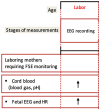Monitoring Fetal Electroencephalogram Intrapartum: A Systematic Literature Review
- PMID: 33042922
- PMCID: PMC7518218
- DOI: 10.3389/fped.2020.00584
Monitoring Fetal Electroencephalogram Intrapartum: A Systematic Literature Review
Abstract
Background: Studies about the feasibility of monitoring fetal electroencephalogram (fEEG) during labor began in the early 1940s. By the 1970s, clear diagnostic and prognostic benefits from intrapartum fEEG monitoring were reported, but until today, this monitoring technology has remained a curiosity. Objectives: Our goal was to review the studies reporting the use of fEEG including the insights from interpreting fEEG patterns in response to uterine contractions during labor. We also used the most relevant information gathered from clinical studies to provide recommendations for enrollment in the unique environment of a labor and delivery unit. Data Sources: PubMed. Eligibility Criteria: The search strategy was: ("fetus"[MeSH Terms] OR "fetus"[All Fields] OR "fetal"[All Fields]) AND ("electroencephalography"[MeSH Terms] OR "electroencephalography"[All Fields] OR "eeg"[All Fields]) AND (Clinical Trial[ptyp] AND "humans"[MeSH Terms]). Because the landscape of fEEG research has been international, we included studies in English, French, German, and Russian. Results: From 256 screened studies, 40 studies were ultimately included in the qualitative analysis. We summarize and report features of fEEG which clearly show its potential to act as a direct biomarker of fetal brain health during delivery, ancillary to fetal heart rate monitoring. However, clinical prospective studies are needed to further establish the utility of fEEG monitoring intrapartum. We identified clinical study designs likely to succeed in bringing this intrapartum monitoring modality to the bedside. Limitations: Despite 80 years of studies in clinical cohorts and animal models, the field of research on intrapartum fEEG is still nascent and shows great promise to augment the currently practiced electronic fetal monitoring. Prospero Number: CRD42020147474.
Keywords: EEG; electrocorticogram; fetus; infant; labor; magnetoencephalogram; neonates.
Copyright © 2020 Castel, Frank, Feltner, Karp, Albright and Frasch.
Figures





References
-
- James SL, Abate D, Abate KH, Abay SM, Abbafati C, Abbasi N, et al. Global, regional, and national incidence, prevalence, and years lived with disability for 354 diseases and injuries for 195 countries and territories, 1990-2017: a systematic analysis for the global burden of disease study 2017. The Lancet. (2018) 392:1789–858. 10.1016/s0140-6736(18)32279-7 - DOI - PMC - PubMed
Publication types
Grants and funding
LinkOut - more resources
Full Text Sources
Medical

